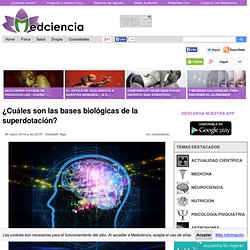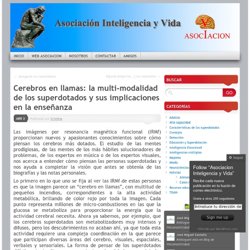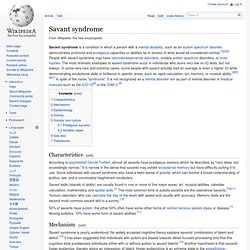

GUIA RAPIDA PARA PROFESORESCON ALUMNOS CON ALTAS CAPACIDADES. Intelligence quotient. IQ scores have been shown to be associated with such factors as morbidity and mortality,[2][3] parental social status,[4] and, to a substantial degree, biological parental IQ.

While the heritability of IQ has been investigated for nearly a century, there is still debate about the significance of heritability estimates[5][6] and the mechanisms of inheritance.[7] History[edit] Early history[edit] The English statistician Francis Galton made the first attempt at creating a standardised test for rating a person's intelligence. French psychologist Alfred Binet, together with Victor Henri and Théodore Simon had more success in 1905, when they published the Binet-Simon test in 1905, which focused on verbal abilities. The score on the Binet-Simon scale would reveal the child's mental age. General factor (g)[edit] The many different kinds of IQ tests use a wide variety of methods. An illustration of Spearman's two-factor intelligence theory. The War Years in the United States[edit] L.L. John B. ¿Cuáles son las bases biológicas de la superdotación? La superdotación se entiende como un alto potencial en todos los ámbitos de la inteligencia (por encima del percentil 75 o generalmente CI superior a 130) tanto de recursos como de capacidades cognitivas.

Son sujetos con buena memoria, observadores, con amplia capacidad de manipulación y comprensión, son buenos solucionadores de problemas. Se entiende por lo general que la superdotación emerge como resultado de la interacción entre factores neurobiológicos, motivacionales y ambientales (es decir, interacción herencia- ambiente), por lo tanto el superdotado nace pero también se hace. Se empieza a ver a partir de los 12-13 años de forma más clara y solo 2 de cada 100 personas son superdotadas. Hoy vamos a centrarnos en las bases neurobiológicas de la superdotación, que si bien no están del todo claras sí siguen por lo general un mismo camino y los resultados de las investigaciones parecen apuntar hacía teorías similares, como iremos viendo.
Cerebros en llamas: la multi-modalidad de los superdotados y sus implicaciones en la enseñanza. Las imágenes por resonancia magnética funcional (IRMf) proporcionan nuevos y apasionantes conocimientos sobre cómo piensan los cerebros más dotados.

El estudio de las mentes prodigiosas, de las mentes de los más hábiles solucionadores de problemas, de los expertos en música o de los expertos visuales, nos acerca a entender cómo piensan las personas superdotadas y nos ayuda a completar la visión que antes se obtenía de las biografías y las notas personales. Lo primero en lo que uno se fija al ver las IRMf de estas personas es que la imagen parece un “cerebro en llamas”, con multitud de pequeños incendios, correspondientes a la alta actividad metabólica, brillando de color rojo por toda la imagen.
Savant syndrome. Savant syndrome is a condition in which a person with a mental disability, such as an autism spectrum disorder, demonstrates profound and prodigious capacities or abilities far in excess of what would be considered normal.[1][2][3] People with savant syndrome may have neurodevelopmental disorders, notably autism spectrum disorders, or brain injuries.

The most dramatic examples of savant syndrome occur in individuals who score very low on IQ tests, but not always. In some very rare and extreme cases, some people with savant actually had an average to even a higher IQ while demonstrating exceptional skills or brilliance in specific areas, such as rapid calculation, art, memory, or musical ability.[4][5][6][7] In spite of the name "syndrome", it is not recognized as a mental disorder nor as part of mental disorder in medical manuals such as the ICD-10[8] or the DSM-V.[9] Characteristics[edit] Mechanism[edit] Savant syndrome is poorly understood. Intellectual giftedness. Intellectual giftedness is an intellectual ability significantly higher than average.

It is a characteristic of children, variously defined, that motivates differences in school programming. It is thought to persist as a trait into adult life, with various consequences studied in longitudinal studies of giftedness over the last century. There is no generally agreed definition of giftedness for either children or adults, but most school placement decisions and most longitudinal studies over the course of individual lives have been based on IQ in the top 2 percent of the population, that is above IQ 130.
The various definitions of intellectual giftedness include either general high ability or specific abilities. For example, by some definitions an intellectually gifted person may have a striking talent for mathematics without equally strong language skills.